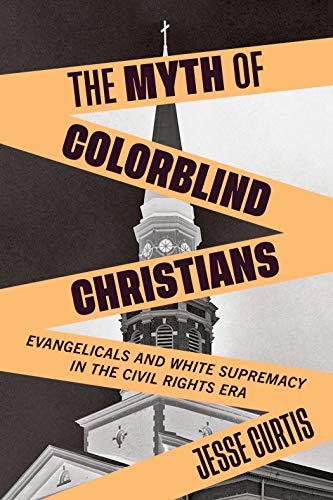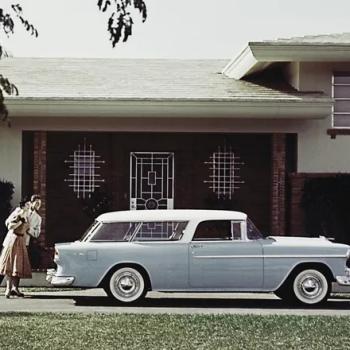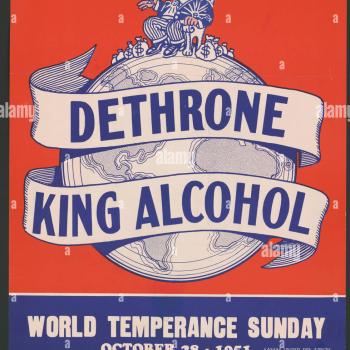I’m pleased to welcome Jesse Curtis to the Anxious Bench. He is an assistant professor of history at Valparaiso University and the author of the just-released The Myth of Colorblind Christians: Evangelicals and White Supremacy in the Civil Rights Era. You can follow Jesse at his blog https://colorblindchristians.com/ and on Twitter @jncthehistorian. What follows is a conversation we had last week about evangelicals and race in the twentieth century. –David
***
David: Christian Smith and Michael Emerson’s Divided by Faith used massive amounts of survey data to critique evangelical racial practices. What do your methodologies and source bases contribute to the scholarly conversation they launched several decades ago?
Jesse: It’s appropriate to start with this book! I encountered Divided by Faith before I was a historian or had any plans to become one. I read it simply as a white evangelical Christian, and it hit very close to home. I was astounded by that book. Their book is a work of sociology at its core, while mine is delving into a historical archive and offering a new account of the history that came before the 1990s moment they described.
My interpretation of this longer history makes the 1990s racial reconciliation moment seem less groundbreaking than it appeared to some observers at the time. White evangelicals were refining and perfecting a script they had been working on ever since the 1950s. If Emerson and Smith captured a snapshot in time, I’m saying, “Let’s roll the tape; it turns out we’ve seen this movie before.” I think this history makes it harder to credit claims of good intentions and well-meaning attempts at achieving racial equality. While Emerson and Smith framed white evangelicals’ counterproductive racial practices as somewhat ironic or tragic, I’m more inclined to see white evangelicals actively achieving the things that are most important to them—and racial equality is very low on that list of priorities.
You open the book with the reaction of megachurch pastor Rick Warren to the 2014 shooting death of Michael Brown in Ferguson, Missouri. Warren tweeted “#AllLivesMatterToGod” and “Racism isn’t caused by SKIN but by SIN.” If you had found this colorblind sentiment in an archival document from 1964 instead of on Twitter in 2014, would you critique it in the same way?
I love this question because I find it so hard to give you a clear answer! I think the short answer is no, because context ought to shape our interpretive choices, and the contextual gap between 1964 and 2014 is large. I did find a woman using the “skin/sin” line in a 1960s letter, and I evaluated her statement as reactionary. But this interpretive choice wasn’t automatic, as if colorblind sentiments are inherently bad, or as if their meaning is fixed. In the case of the 1960s letter, my interpretation had to account for her social position, the rest of the contents of the letter, the events happening at the time, and so on. Part of the whole point of this book is that theological language of race, including scripture itself, is not inherently freeing or oppressive. It depends on context and purpose!
Gosh, my whole life led me here. This is a subject for another book someday. Suffice it to say, as a young adult I had a tangled journey of realizing I was a white Christian racist. Only the Christian part of that identity had been visible to me until I moved to Chicago for college in 2005.
That’s the deep background. The shorter story is that I began my PhD work at Temple University in August, 2014, the very month Michael Brown was killed in Ferguson, Missouri. I saw how my fellow white evangelicals were reacting to the protests, and I didn’t like it. I could hardly focus on my work. I wanted to know more about why my religio-racial tradition acted this way. That was the beginning. So, for me, it was important that the first paragraph of the book start with Michael Brown’s death. This is a black lives matter book.
Back in the day I was the editor of a student newspaper at an evangelical college. I remember how raw some of our work was, so I imagine you bumped into some real gems. Can you share a couple of the funniest or poignant or painful sources you encountered?
There was some funny stuff for sure, but the one that comes immediately to mind isn’t funny at all. I mention this in the book, but there was a black student at Houghton College in the 70s who wrote in the student newspaper about the racism and alienation she experienced on campus. I’ve always thought it was courageous of her to write that. The line that is seared into my mind is this: “I had to stay really close to the Lord to keep from committing suicide.”
My own work has chronicled how missionaries often acted as a progressive force for racial change. Your chapter entitled “Growing the Homogeneous Church” offers an important corrective to that single story. How did the so-called “homogeneous unit principle” developed by missiologists encourage evangelicals to double down on, rather than challenge, whiteness?
It provided a missiological justification for focusing on the growth of white congregations. It was quite seductive. Here you had this scientific-sounding jargon coupled with a supposedly gospel-centered desire to see churches grow. And it turned out homogeneous churches grew fastest of all! Leading experts of church growth ripped whiteness completely out of its context of ongoing harm, describing it as a healthy expression of pluralism. Middle class white evangelicals were just as entitled to homogeneous worship as a foreign-language immigrant congregation. It was all part of America’s dynamic mosaic of peoples. People like to worship with people like themselves. Give them what they like. For experts like Donald McGavran and C. Peter Wagner, this was explicitly race-conscious. On the ground, it justified and enabled white spaces where race could be ignored and colorblind theology could flourish.
When black evangelicals and other critics raised the alarm about the ethics of this investment in whiteness, church growth experts had their trump card in hand: what could be more important than people becoming Christians? Don’t we have to use the most effective methods possible? This was all taking place in a context of the crisis of the American city and white suburbanization. Ordinary white evangelicals and their congregations effectively exacerbated the crisis of American racial inequality, as Mark Mulder showed so well in Shades of White Flight. But their self-conception was that they were simply biblical Christians trying to spread the gospel. It’s these kinds of stories that I have in mind when I talk about white evangelicals investing in whiteness as evangelicals. They deliberately used race for their purposes, while at the same time constantly criticizing black evangelicals when they brought up race. It’s as if they said, my use of race reflects my commitment to the gospel; your use of race is a distraction from the gospel. These pernicious narratives remain dominant in white evangelicalism right up to the present day.
In one of your final chapters, you describe a group of black evangelicals who challenged colorblind Christians. Could you describe the content and reaction to Clarence Hilliard’s article “Down with the Honky Christ,” which was published in Christianity Today in the 1976?
The black evangelical story is absolutely crucial, and it’s been overlooked. Black evangelicals were pioneers of a kind of colorblind theology in evangelicalism. They used it in the 1950s and 1960s to call for change. Paul says we’re one in Christ. If that’s so, said black evangelicals, you must include us. In the context of open discrimination, these colorblind interpretations of scripture were powerful indictments of white evangelicalism. But white evangelicals turned the tables, using the same kinds of rhetoric to silence criticism. The basic rhetorical move shifted as white evangelicals said, if we’re one in Christ, you shouldn’t be talking about race.
So by the late 1960s and early 70s, you see black evangelicals becoming more race conscious, recognizing the ways scripture was being deployed against them. I still can’t believe Christianity Today published this piece from Clarence Hilliard in 1976. In it, Hilliard basically brings the long African American tradition of a black Christ to the pages of white evangelicalism’s flagship magazine. It’s a searing critique of people like Donald McGavran and Billy Graham, who Hilliard accused of peddling a cheap personal relationship kind of salvation that didn’t call on people to follow the ethical commitments of Christ. Hilliard comes right out and says that Christ is black and true followers of Christ will become black. He’s not talking about phenotype, of course, but a way of seeing and living in an unjust world. In a racist society, blackness was the closest connection Americans could envision to the upside-down values of the Kingdom of God. Hilliard thought the evangelical mainstream was rejecting this demanding path of theological blackness and chasing after the shiny rewards of a theologically white Christ. The influence of James Cone on Hilliard is obvious, and that fact alone would be enough to make him seem to most white evangelicals like a dangerous gadfly.
Amidst profound racial tensions in the wake of the O. J. Simpson trial and the Million Man March in the 1990s, the racial reconciliation work of Promise Keepers seemed very promising. Many observers thought that the movement could offer racial healing on a national scale. Why didn’t it turn out that way?
Because it’s not what ordinary white evangelicals wanted. McCartney (PK’s founder) himself pointed to this at the time. Even when packaged in evangelical idiom and bathed in scripture, most white evangelicals didn’t want to talk about race. And why would they? They supported the racist status quo.
Many readers of this blog will have recently listened to Christianity Today’s podcast “The Rise and Fall of Mars Hill” and read books like Beth Allison Barr’s The Making of Biblical Womanhood and Kristin Kobes DuMez’s Jesus and John Wayne. How do the dynamics of racialized evangelical power you describe resemble or differ from those of gender? How do they intersect?
There’s much that could be said on this, but I’ll just note one foundational difference in the rhetorical dynamics at play here. Gender hierarchy is actively advocated and proudly defended in large swaths of evangelicalism, while racial hierarchy is nearly everywhere condemned. The same people who preach that the Bible teaches male headship also tend to preach that the Bible rejects racial hierarchy. So even though both gender and racial hierarchy are widely practiced, the rhetorical context around them is quite distinct. This has practical consequences insofar as many white evangelicals participate in practices and institutions of racial hierarchy but are unable to see them for what they are.
What are you working on now?
Trying to stay sane while being the best father and teacher I can be. I hope space will open up for my next book project sooner rather than later, but I don’t yet know what.


















